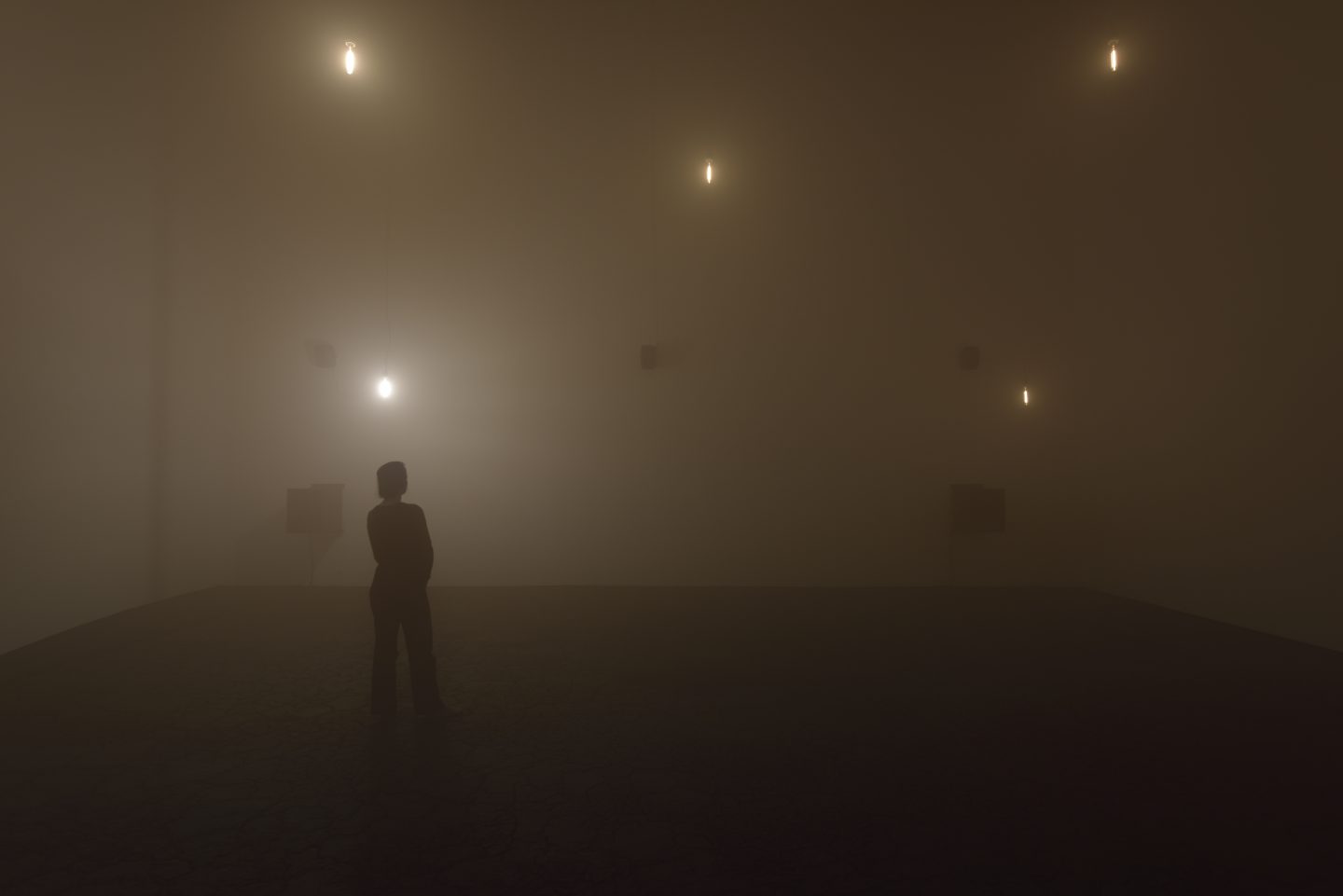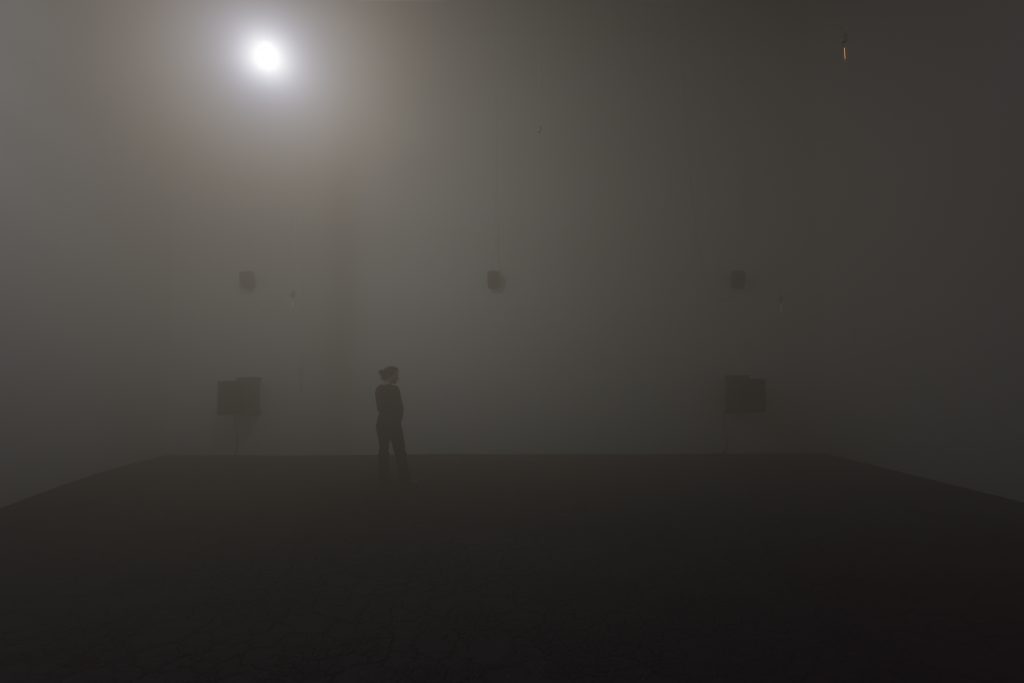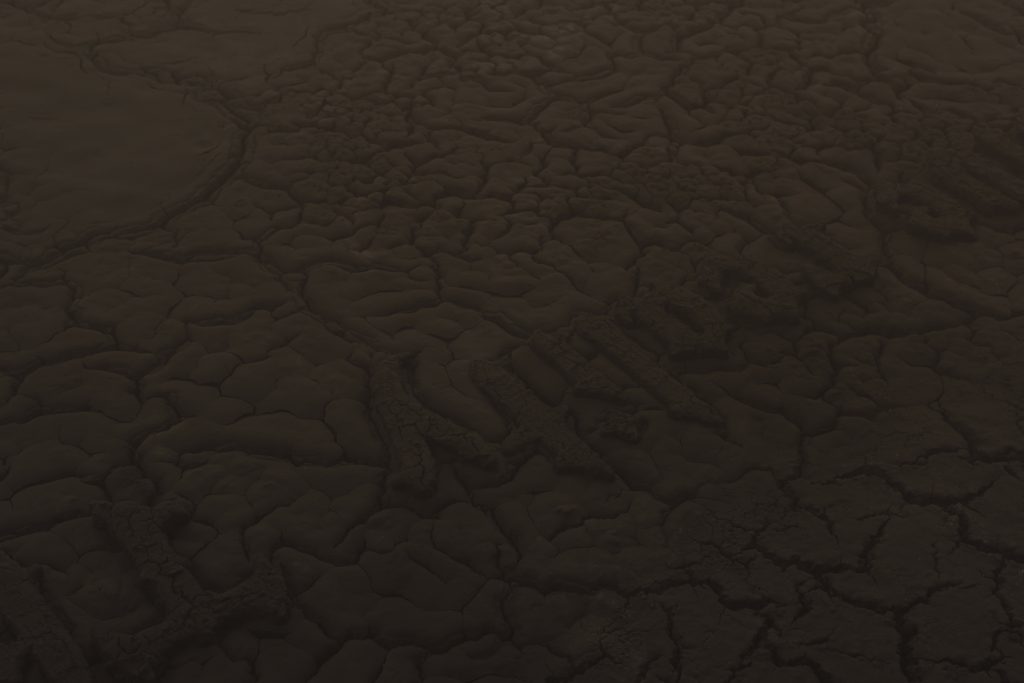Korakrit Arunanondchai’s the blood of the earth occupies the large white cube of Le Consortium in Burgundy, a region known for its biodynamic viticultural rituals. The work presents a materialist and minimalist artistic strategy – as if Walter de Maria’s Earth Room had caramelised into a cracked, shiny black crust spread across the entire surface of the space. The artist imagines the blood of the earth as a painting, a stage, and a film without an image. Unlike the void of the cinema constructed by darkness, the white cube constitutes a different kind of void. A sprawling cracked surface with a prayer text sculpted from the ground forms a rectangle bordered by a looped litany:
“The Blood of the Earth, Connects us all in the landscape of mourning, The sky drenched in flames, The sun of consciousness, Will recreate this world, With unanswered prayers, Let there be splendor, Beyond the upheaval, Love after death, A song to survive reality, The Ghost takes us by the hand, Decompose…”
The work was originally installed at the Bangkok Kunsthalle, formerly a printing house for government-approved educational books, which caught fire twenty years ago. The artist reconstitutes the ashes from the fire to form the floor of the original installation. For the Dijon presentation, ash from the Kunsthalle has been combined with earth collected locally in Burgundy.
While negative space is central to the installation, sound creates three distinct layers in the space: an underworld of sub-bass rumble, an upper realm of atmospheric recordings and church-like choruses, and an earthly layer linking ground to sky through a performative ritual, where performers generate heat for the phoenix. Their absence lingers, haunting the space.
Previously presented at: Museum MACAN, Jakarta, Indonesia, 2024 (Nostalgia for Unity); Kunsthalle Bangkok, 2024 (Image, Symbol, Prayer); Kukje Gallery, Seoul, 2022.
Photos: Rebecca Fanuele © Consortium Museum.
This exhibition is supported by M Art Foundation as part of its commitment to the Consortium Museum’s Asia Pacific Society program.
Korakrit Arunanondchai (b. 1986, Bangkok, Thailand, living and working between New York and Bangkok) is an artist who works across painting, video, installation, performance, and immersive environments. He studied at the Rhode Island School of Design (RISD) and Columbia University. His practice incorporates painting, single and multi-channel filmic installations, dystopian environments bathed in orange hues and fog, with prayers sculpted from ash, paint and earth in Neo-Gothic font, and soundscapes that combine techno-animistic sensibilities with malevolent invocations.
Arunanondchai’s immersive installations have been presented internationally for over a decade at major contemporary art institutions and biennials including Palais de Tokyo (2015), SMAK, Ghent (2016), Serralves Museum, Porto (2020), Singapore Art Museum (2022), Venice Biennale (2019), Whitney Biennial (2019), Museum MACAN, Jakarta (2024), Kunsthalle Bangkok (2024), Kukje Gallery, Seoul (2022), and many others.
A central concern in his work is the experience of time through the body, and the way ritual, memory, and spirituality intersect with political and historical narratives. Arunanondchai frequently references and adapts post-modern rituals such as the ongoing “Ghost Cinema” in northeastern Thailand, where monks project films onto temple walls for ghost audiences – a practice that traces back to the Vietnam War era, when American soldiers used 8mm projectors to create light shows intended to frighten villagers.
His major ongoing video series include No history in a room filled with people with funny names and Songs for Dying/Songs for Living, both of which combine personal narrative with broader mythologies, socio-political histories, and techno-spiritual imaginaries. Fire is both subject and process in his paintings, which bear the physical traces of destruction alongside digital reproductions of ritualistic burnings, integrated within total environments where video, sound, and sculpture accumulate across venues.



